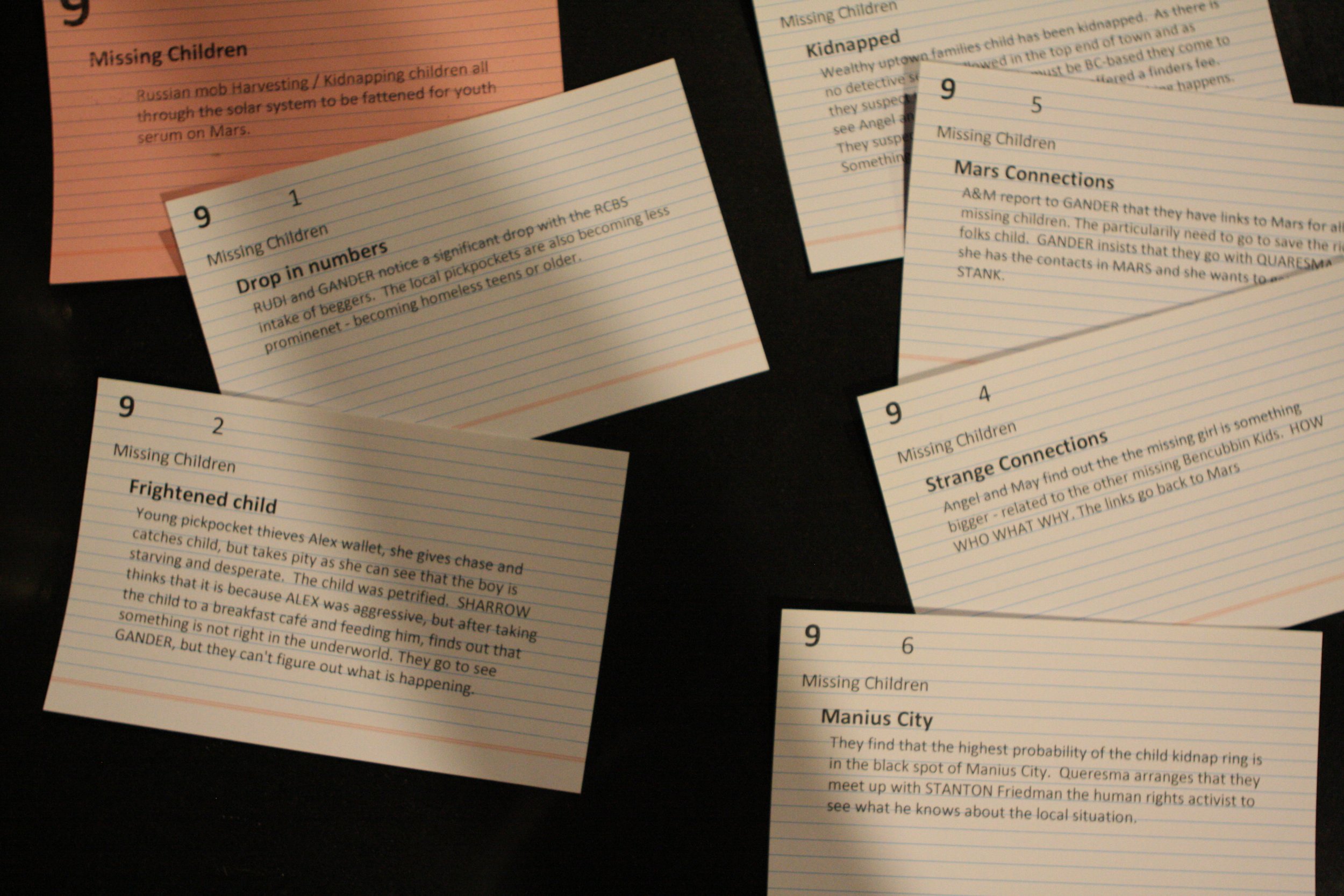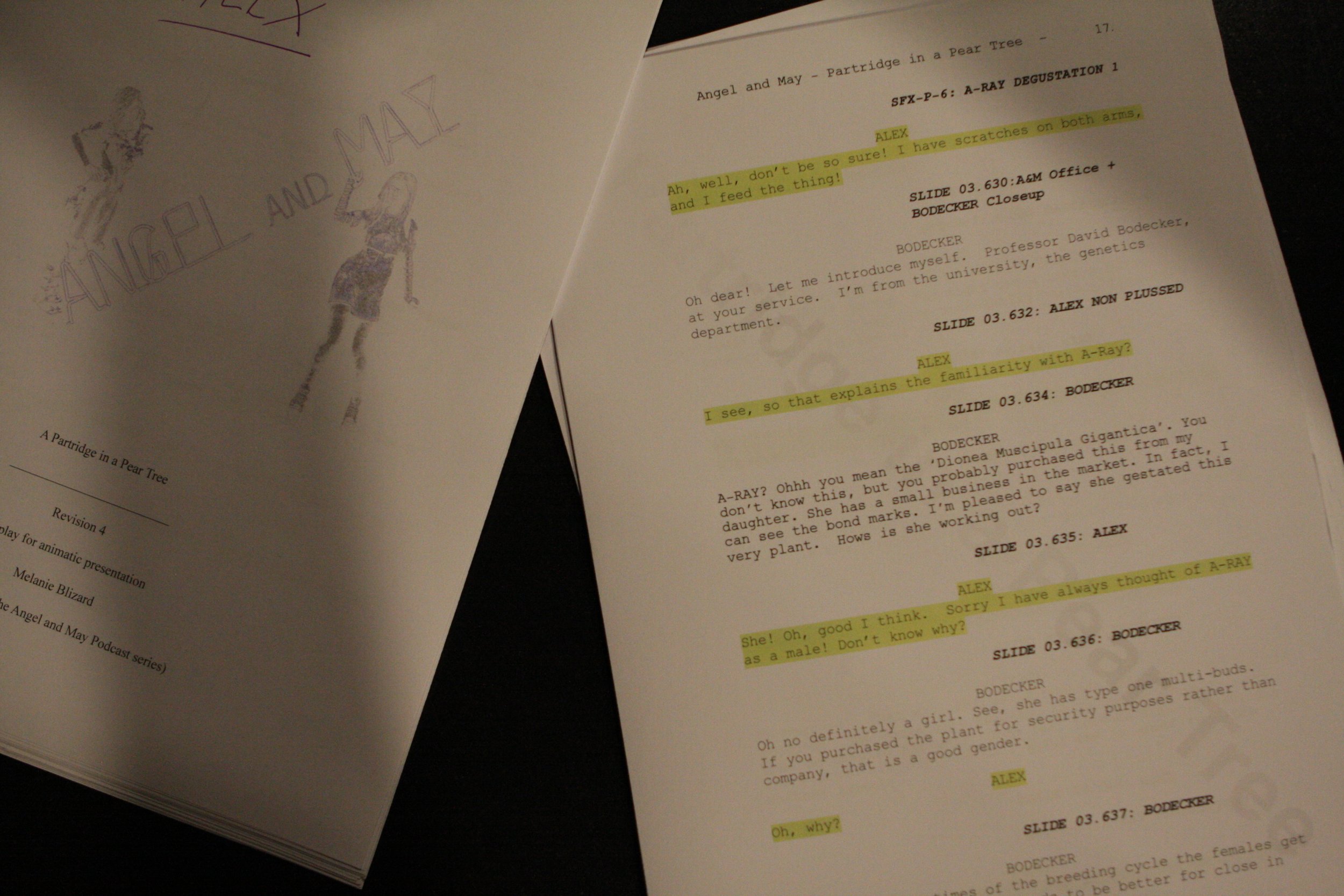Stage 1 - Create the story arcs and beats
This involves multiple workshops where ideas are kicked around with key points being recorded on cards. These key inflexion points are sorted on display whiteboards. The cards are cleaned up and entered into the main Access database for tracking and printing purposes. These generally map to paragraphs or even scenes in a production.
Stage 2 - Develop the Scripts
This is a long process where writing takes place from a story arc point of view. Once the story arcs are completed. The individual scenes are composited together into the episodes. If story arcs interleave, this is where that process takes place. Rewriting around the split points to leave hooks for the next episode will then take place. Episodes are collated such that the length is around half an hour. This is difficult to judge exactly because of sound effects so word counts are only a rough guide. From this point the script more or less drives everything. The Final draft software is used for this process.
Stage 3a - Pre-Production Data
This involves entering data into the tracking access database, such that each episode is enumerated, the characters contained in that episode with word counts and the chapters are all entered. A short description and a long description are written. These are later used with Buzzsprout for the streaming meta data.
Stage 3b - Graphics Pre-Production Data
At this point, the episodes are quantified and a start can be made on creating a rendering up the artwork for each episode. This usually takes a single scene and imagines what a moment in time might look like. This is done in DAZ studio and the images are rendered up as both high a low-resolution images.
Stage 3c - Cubase Templates
For each episode, a Cubase file and folder system is set up, from a standard template. Each character has their own channel, so if a character is not in an episode unnecessary channels can be removed. A guide track is read in (usually by the producer) covering the whole script with all the parts. The parts are then separated and distributed to the appropriate channel (or track). At this stage, no sound effects are entered. The templates contain the looped samples for the ambient noises, but these are pushed past the vox entries such that editing will not affect them.
Stage 4a - Recording the Vocal Expressions
Each actor is invited into the studio and will overdub their voice parts over the guide as this is done the guide is removed for their parts. In this way, the episode is built up piece by piece like a giant jigsaw, becoming more and more like the final version. The tricky part is that all the spacing timewise has to constantly be adjusted so that the pacing of the piece is correct and that voices don’t overlap. This process takes multiple months.
Stage 4a - Recording the Vocal Expressions
When we first started, multiple performers worked in the studio at a time, this was great for interactions, but it did mean that those folk who were not performing had to sit around! Then COVID happened which meant that we moved to individual recording. As a different performer could come in each evening this greatly speeded up the efficiency of the vocal capture at the expense of the human interaction. This shows Priya playing KRIS and Cecila playing SHARROW in the first season.
A behind-the-scenes look at the production of Angel & May
Stage 4b - Recording the Overdubs
Once the basic vocals for all parts are in, the episode can be reviewed as a whole. This is where poor acting or tone or script modifications can be corrected with overdubs. This can be quite a painful and long-winded process again taking months! A notation track is used with the numbers linking into notes in the access database.
Stage 4c - Scene Demarcations
The demarcations for the end of each scene are defined, with a marker. Audio cues are inserted to cover the overlap, this hides the abrupt scene ambient and reverb changes and tells the audience that a new scene has started.
Stage 5a - Space Modelling
A crucial but often overlooked aspect is that for each scene the reverberation and reflection of the space have to be modelled, this is done by sending all tracks to common SFX channels and then controlling the volume for each scene both for early reflections and for longer reverberations. In addition, there is always a low-level ambient noise for each scene, such as air conditioning, or machines beeping. This is done using ambient channels which are again controlled volume-wise for each scene. For most scenes, this does not change through the scene, but in certain circumstances, changes are required within a scene.
Stage 5b - Ambient Noise Modelling
There is always a low-level ambient noise for each scene, if this was not there it just sounds wrong, empty. Once ambient sounds are entered it somehow comes alive. Things such as air conditioning, machines beeping or spacecraft rumbling, streets noises. This is done using ambient channels which are again controlled volume-wise for each scene. Quite a lot of effort goes into these at the beginning of each season and then they come pre-pasted via the template. The best bit is that once these are in the whole thing becomes so much more real!
Stage 5c - Specialised Ambient Noise Modelling
The standardised ambients are never normally sufficient. Things such as cars passing or street-sweepers just lift the whole realism level. So at this point, these extra ambients are added to the Foley Special channels. This is usually done on channel 1
Stage 5d - General SFX
There are five channels dedicated to general foley special effects and this is the part that I like. Seeking out these SFX samples takes around a week or so for each episode. We have several gigabytes of the library for this, but I also use the ‘Freesound’ index website, whose services are invaluable. Contributions are made to support this site. The worse thing by far is the radio bleeps every time someone talks in a spacesuit, hundreds of samples all having to be entered in exactly the right place!
Stage 5e - Doors and Footsteps
Doors all have to be entered at this point, this is done on dedicated channels as with footsteps foley, again this takes a couple of evenings to get right, but it’s well worth it. Space ship doors are insane but so much fun!
Stage 6 - Titles and Credits
The introductory title and outro titles need to be entered. These have previously all been recorded at the beginning of the season based on database information. Actor changes are a pain because this has to be rerecorded to take account of these changes.
Stage 7 - Final Mix, Rendering & Mastering
This is much, much harder than you might think, especially with an audio drama with large dynamic range. The aim is to make it all clear without to much compression and messing around. Level wise its normalised to EBU R-128
Stage 8 - Upload
Audio is uploaded to Buzzsprout, which involves feeding a load of meta data and ancillary uploads like chapter marking and transcripts. Data is also uploaded to soundcloud which feeds the samples on this website.
















